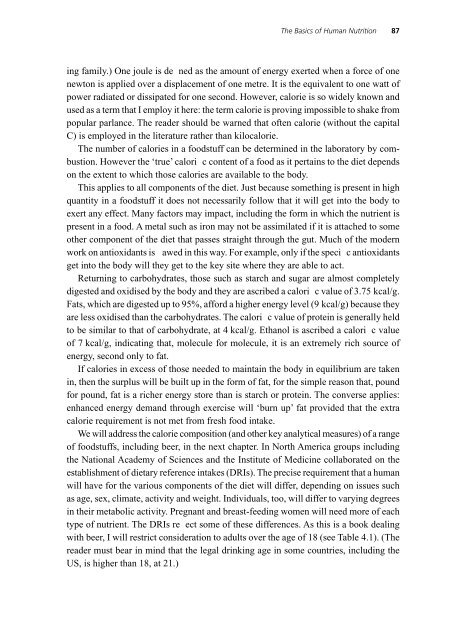Beer : Health and Nutrition
Beer : Health and Nutrition
Beer : Health and Nutrition
Create successful ePaper yourself
Turn your PDF publications into a flip-book with our unique Google optimized e-Paper software.
The Basics of Human <strong>Nutrition</strong> 87<br />
ing family.) One joule is de ned as the amount of energy exerted when a force of one<br />
newton is applied over a displacement of one metre. It is the equivalent to one watt of<br />
power radiated or dissipated for one second. However, calorie is so widely known <strong>and</strong><br />
used as a term that I employ it here: the term calorie is proving impossible to shake from<br />
popular parlance. The reader should be warned that often calorie (without the capital<br />
C) is employed in the literature rather than kilocalorie.<br />
The number of calories in a foodstuff can be determined in the laboratory by combustion.<br />
However the ‘true’ calori c content of a food as it pertains to the diet depends<br />
on the extent to which those calories are available to the body.<br />
This applies to all components of the diet. Just because something is present in high<br />
quantity in a foodstuff it does not necessarily follow that it will get into the body to<br />
exert any effect. Many factors may impact, including the form in which the nutrient is<br />
present in a food. A metal such as iron may not be assimilated if it is attached to some<br />
other component of the diet that passes straight through the gut. Much of the modern<br />
work on antioxidants is awed in this way. For example, only if the speci c antioxidants<br />
get into the body will they get to the key site where they are able to act.<br />
Returning to carbohydrates, those such as starch <strong>and</strong> sugar are almost completely<br />
digested <strong>and</strong> oxidised by the body <strong>and</strong> they are ascribed a calori c value of 3.75 kcal/g.<br />
Fats, which are digested up to 95%, afford a higher energy level (9 kcal/g) because they<br />
are less oxidised than the carbohydrates. The calori c value of protein is generally held<br />
to be similar to that of carbohydrate, at 4 kcal/g. Ethanol is ascribed a calori c value<br />
of 7 kcal/g, indicating that, molecule for molecule, it is an extremely rich source of<br />
energy, second only to fat.<br />
If calories in excess of those needed to maintain the body in equilibrium are taken<br />
in, then the surplus will be built up in the form of fat, for the simple reason that, pound<br />
for pound, fat is a richer energy store than is starch or protein. The converse applies:<br />
enhanced energy dem<strong>and</strong> through exercise will ‘burn up’ fat provided that the extra<br />
calorie requirement is not met from fresh food intake.<br />
We will address the calorie composition (<strong>and</strong> other key analytical measures) of a range<br />
of foodstuffs, including beer, in the next chapter. In North America groups including<br />
the National Academy of Sciences <strong>and</strong> the Institute of Medicine collaborated on the<br />
establishment of dietary reference intakes (DRIs). The precise requirement that a human<br />
will have for the various components of the diet will differ, depending on issues such<br />
as age, sex, climate, activity <strong>and</strong> weight. Individuals, too, will differ to varying degrees<br />
in their metabolic activity. Pregnant <strong>and</strong> breast-feeding women will need more of each<br />
type of nutrient. The DRIs re ect some of these differences. As this is a book dealing<br />
with beer, I will restrict consideration to adults over the age of 18 (see Table 4.1). (The<br />
reader must bear in mind that the legal drinking age in some countries, including the<br />
US, is higher than 18, at 21.)

















